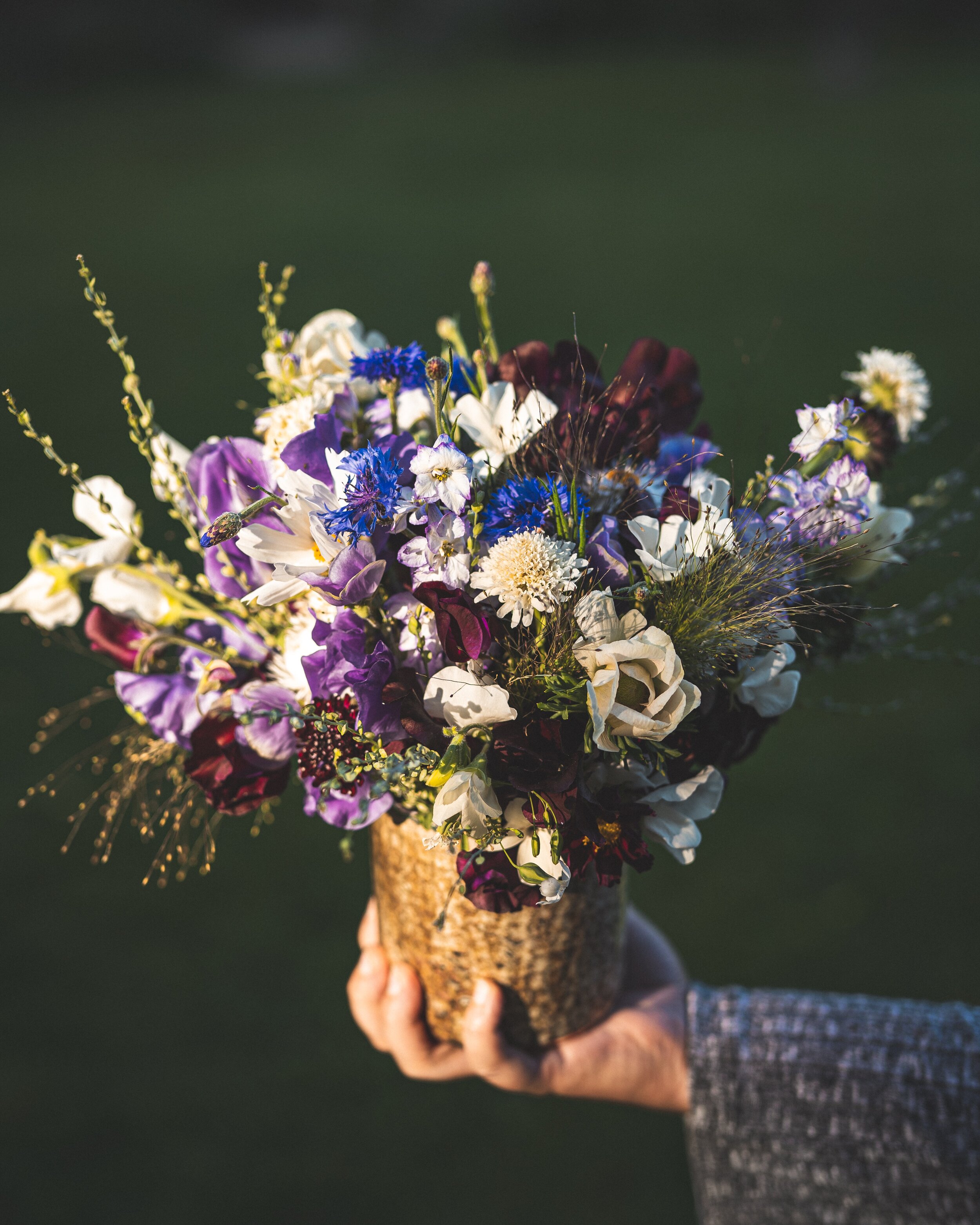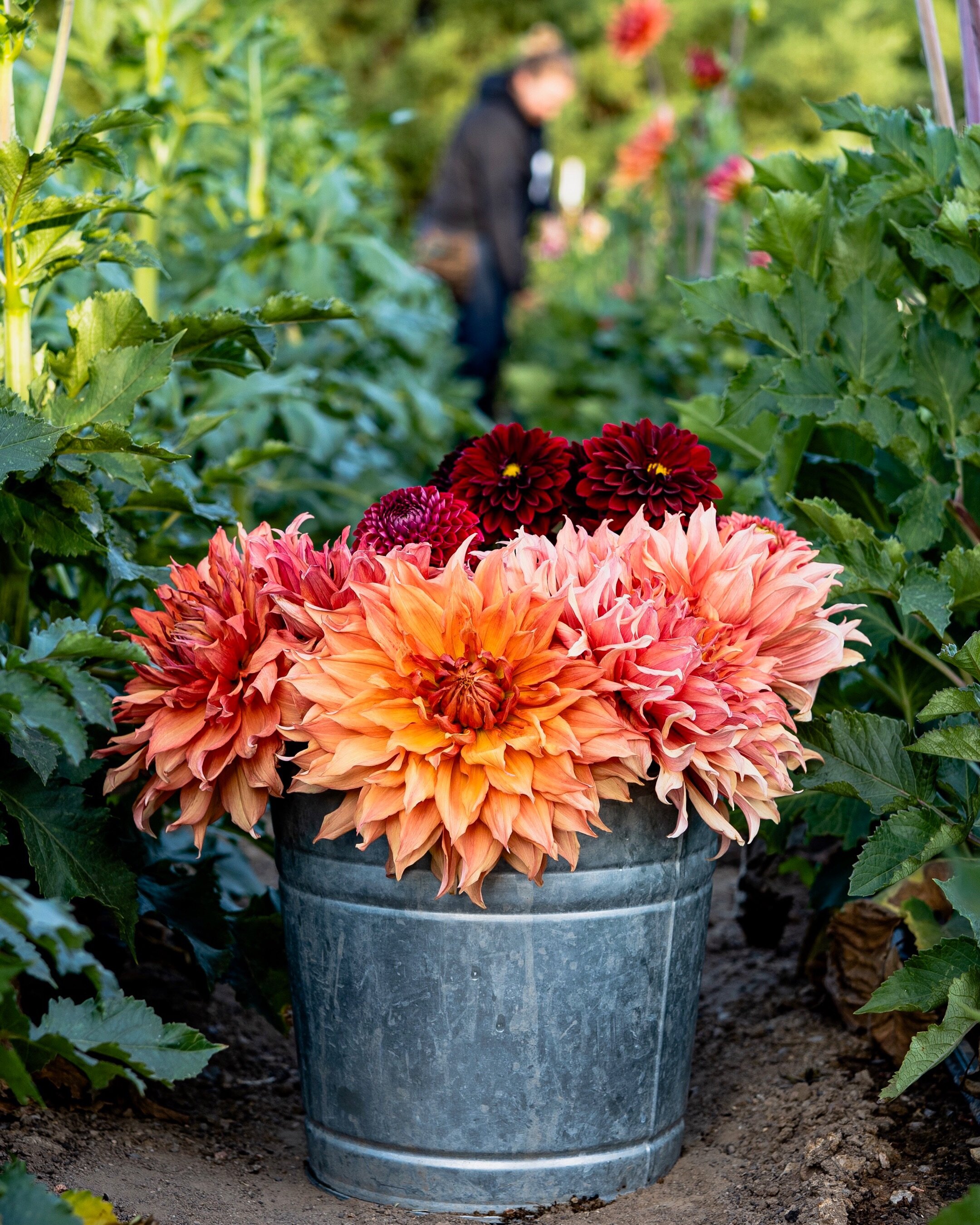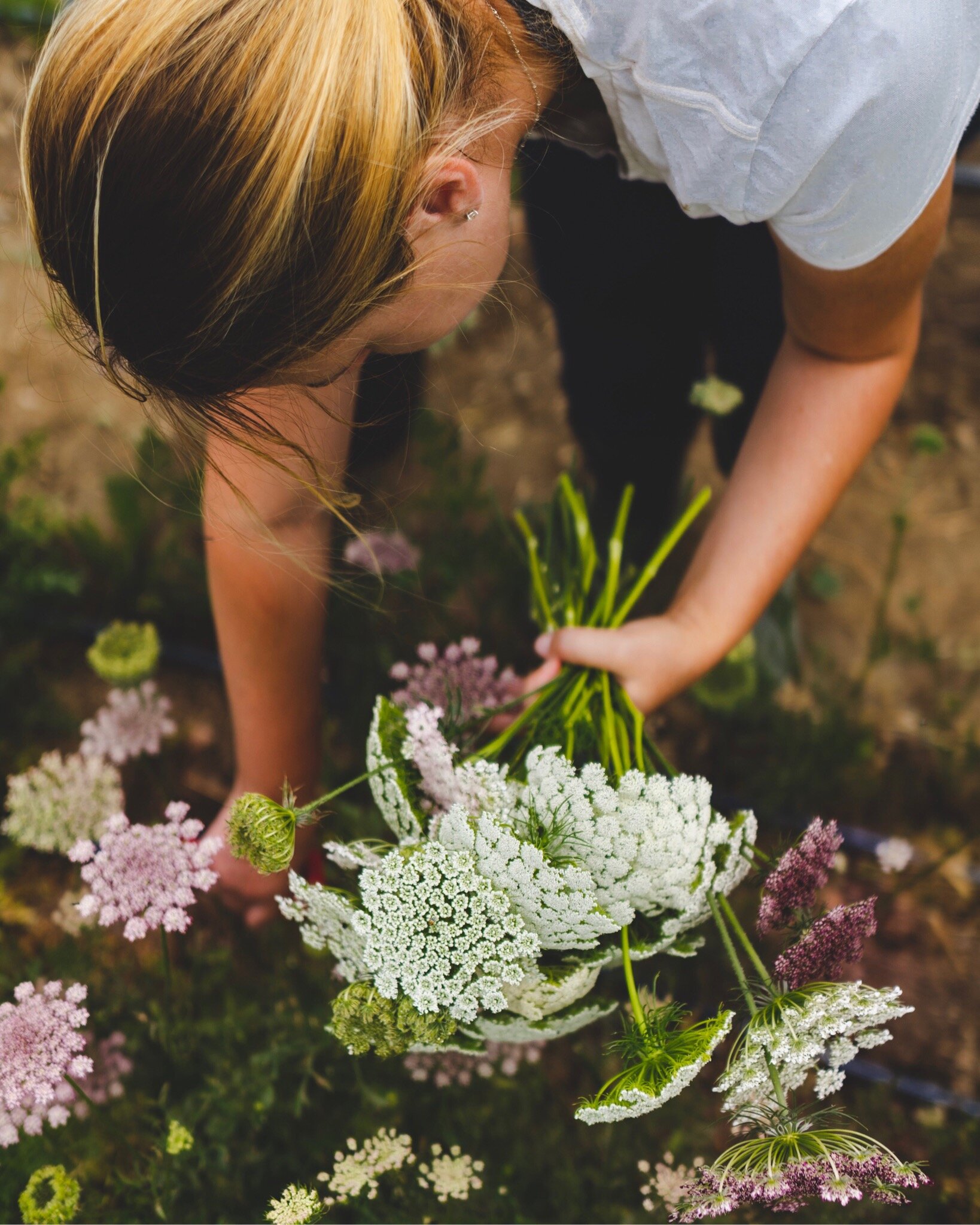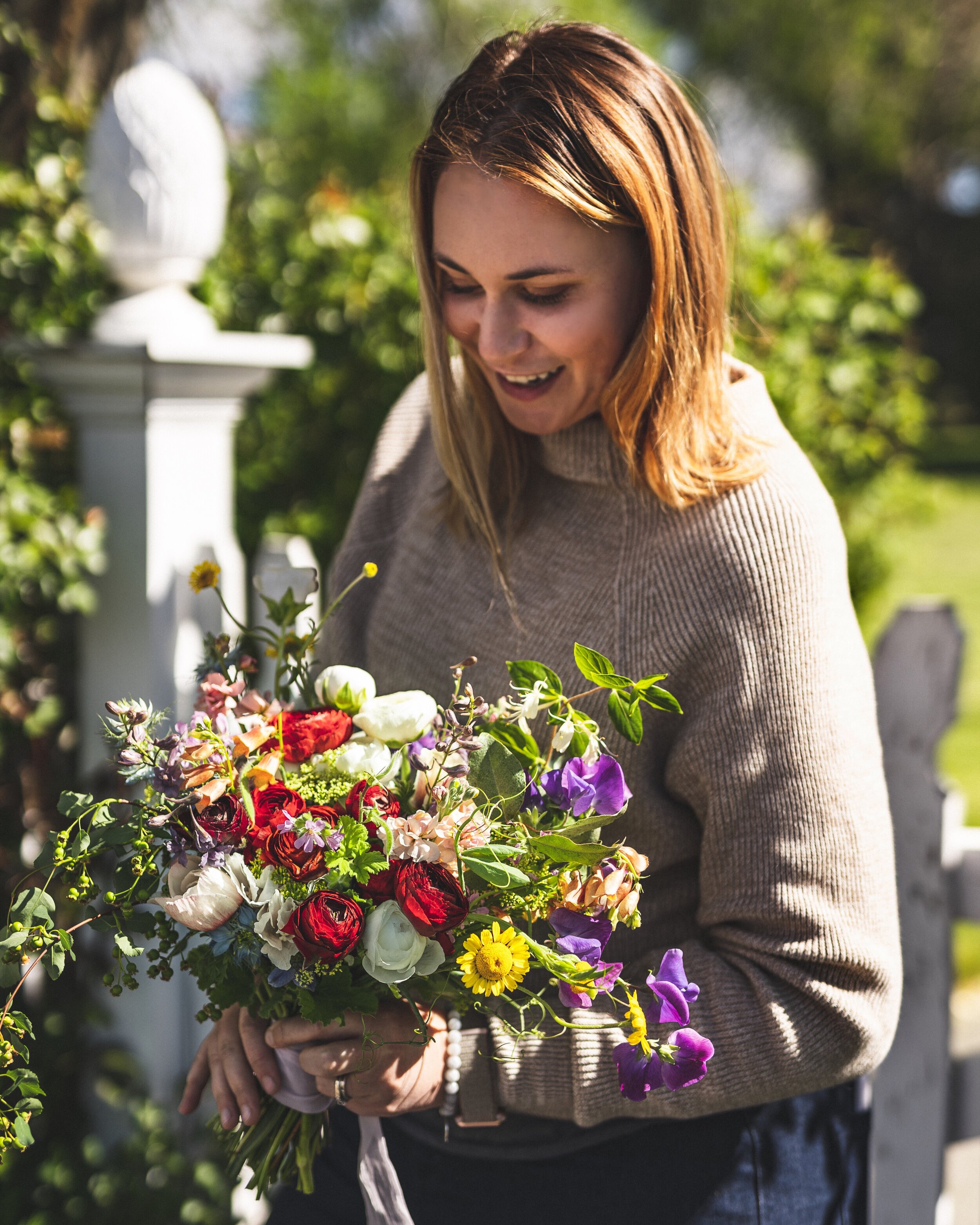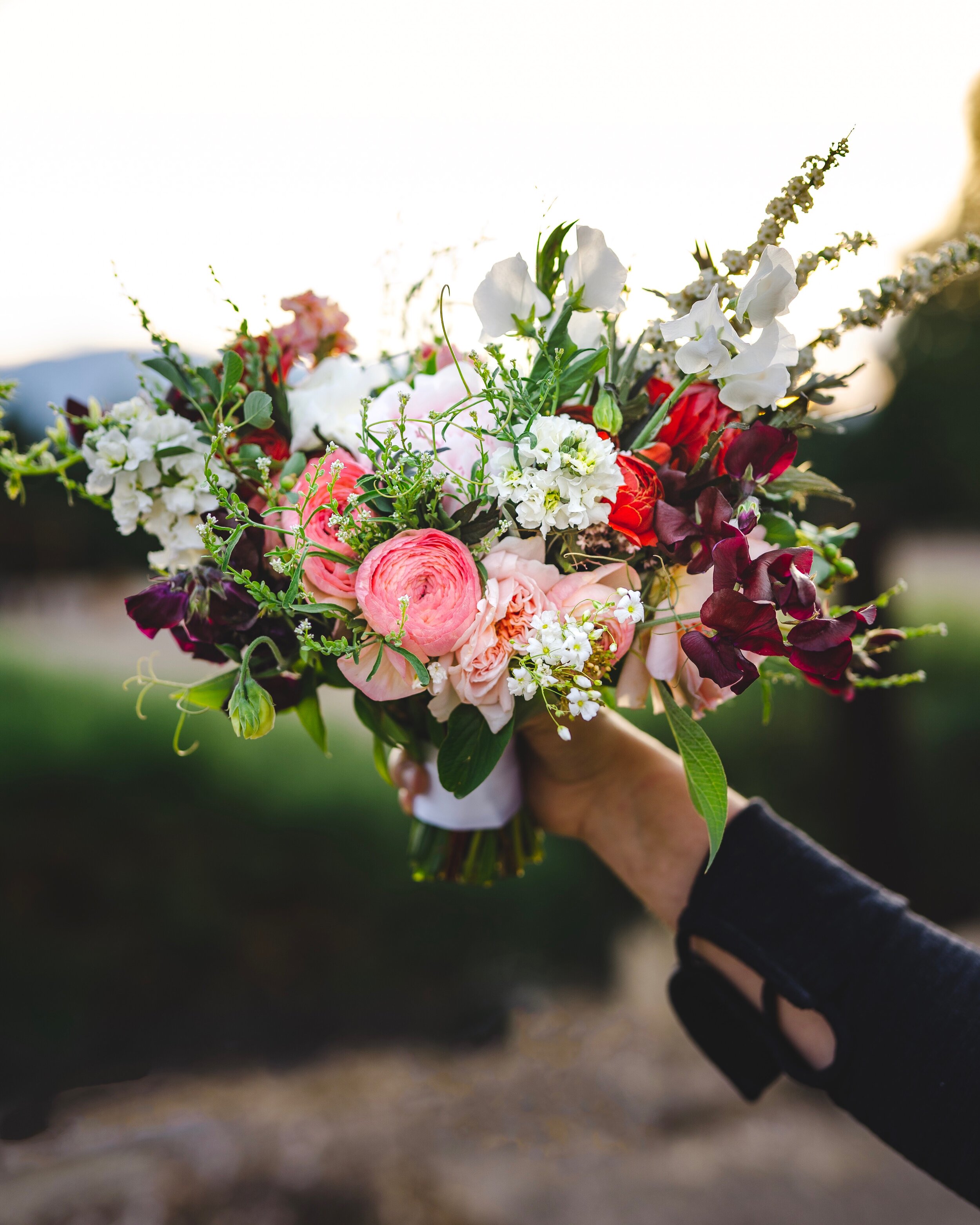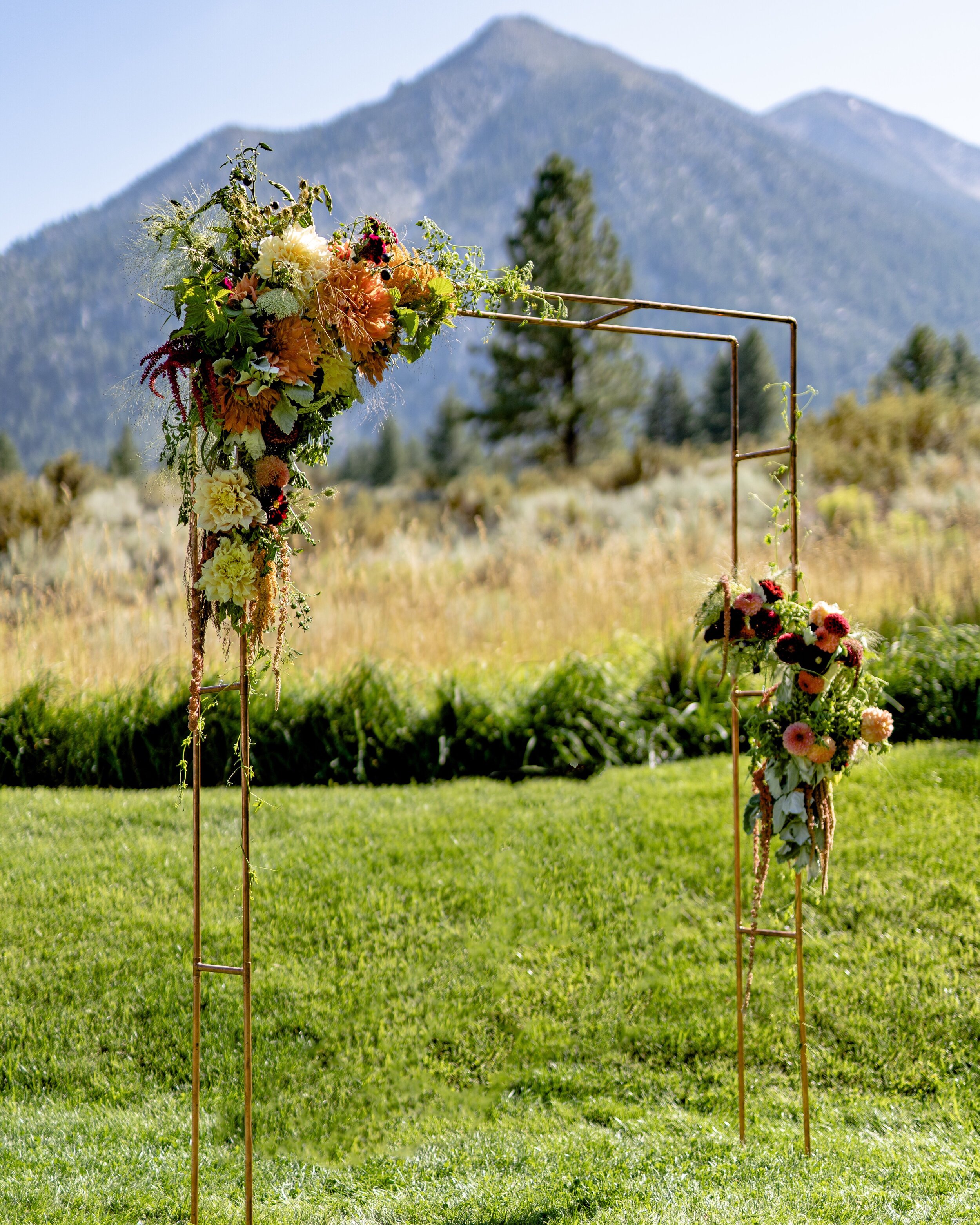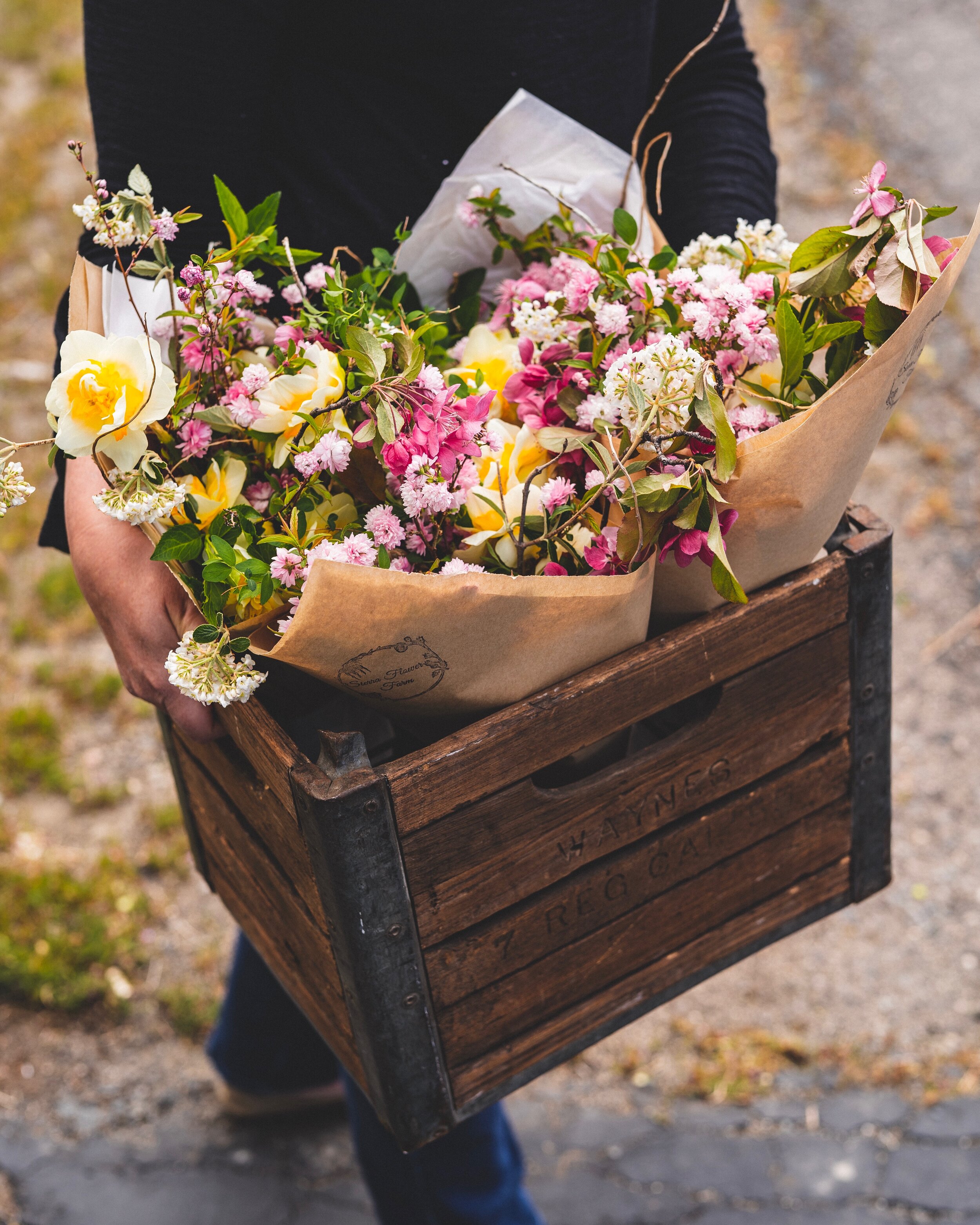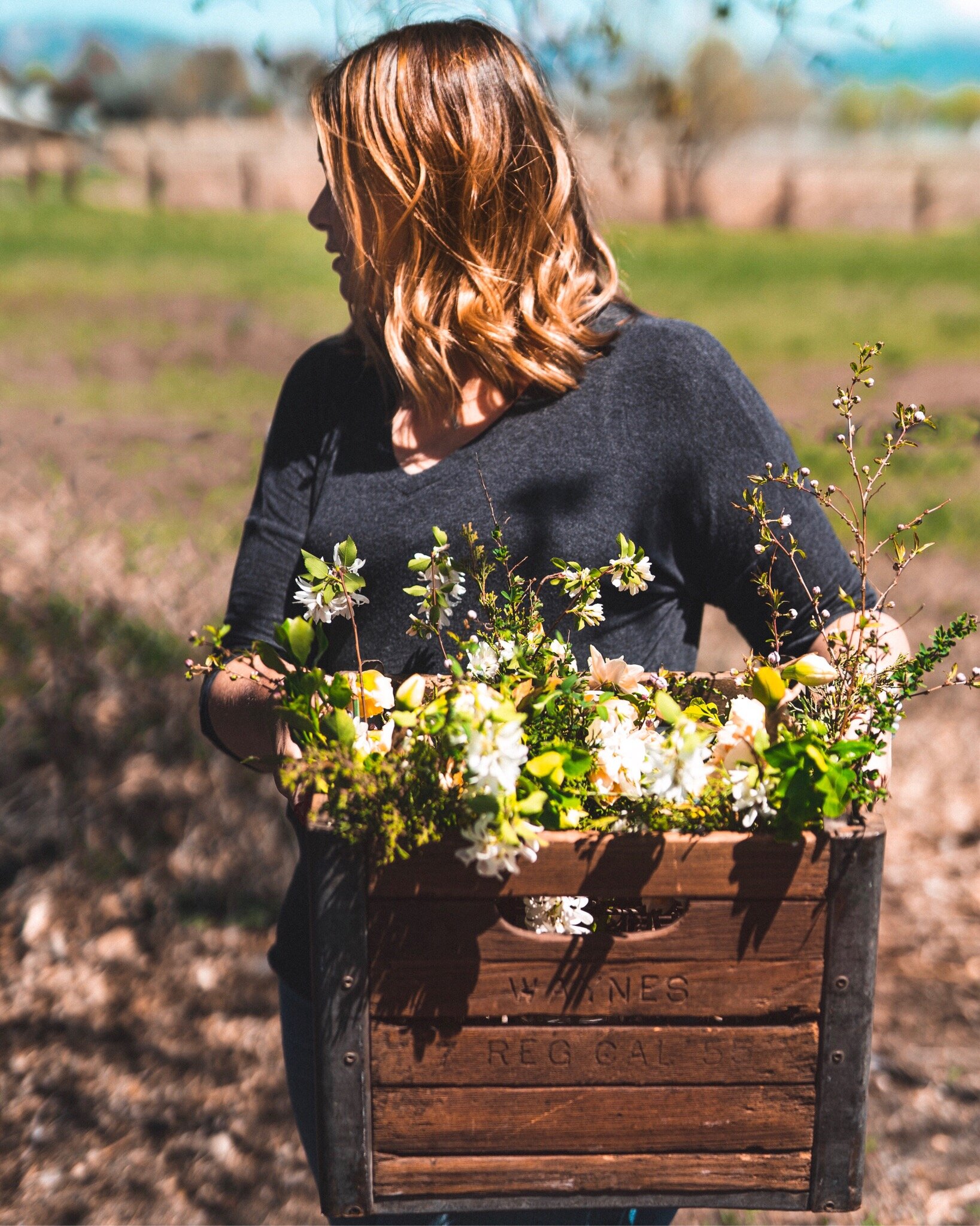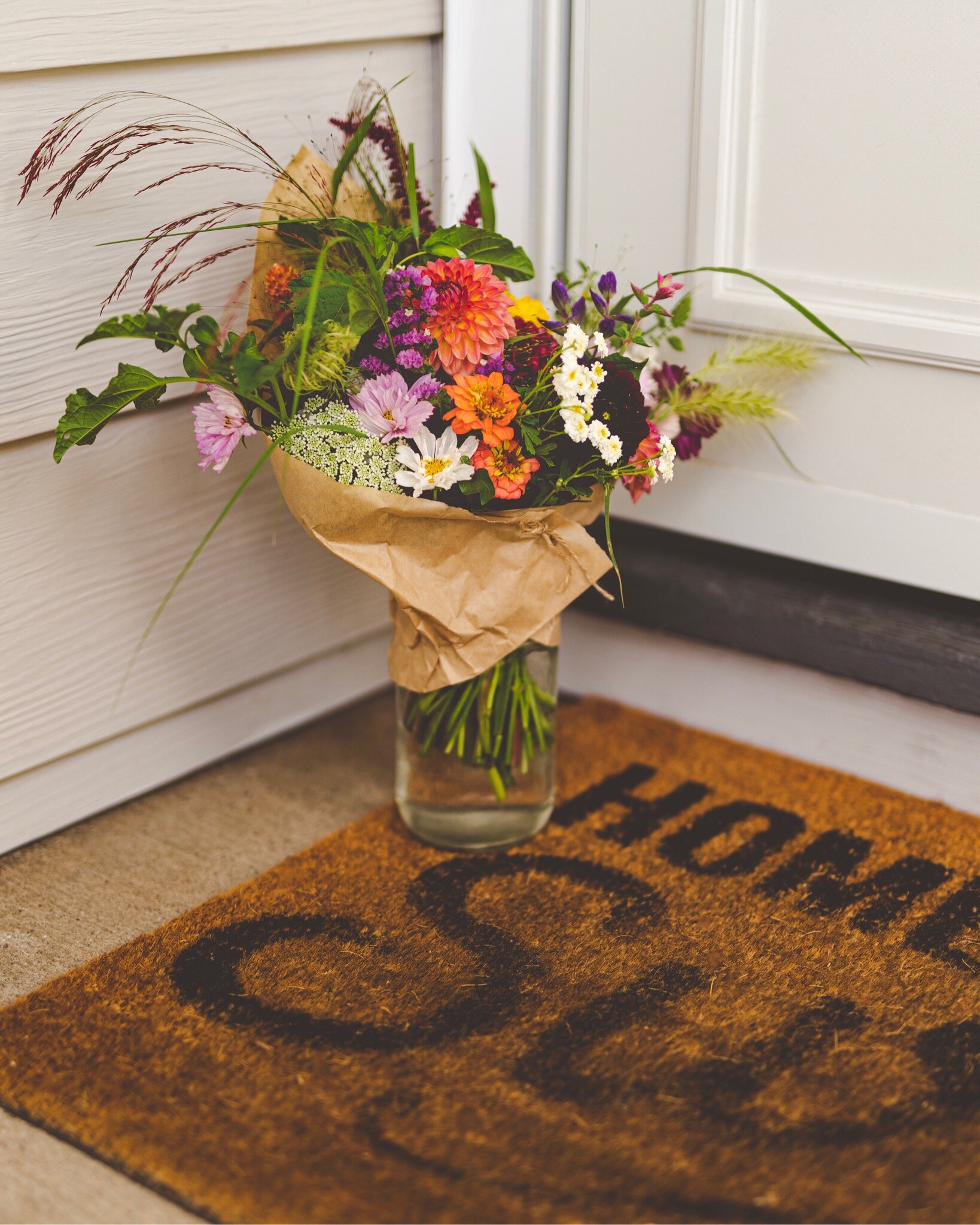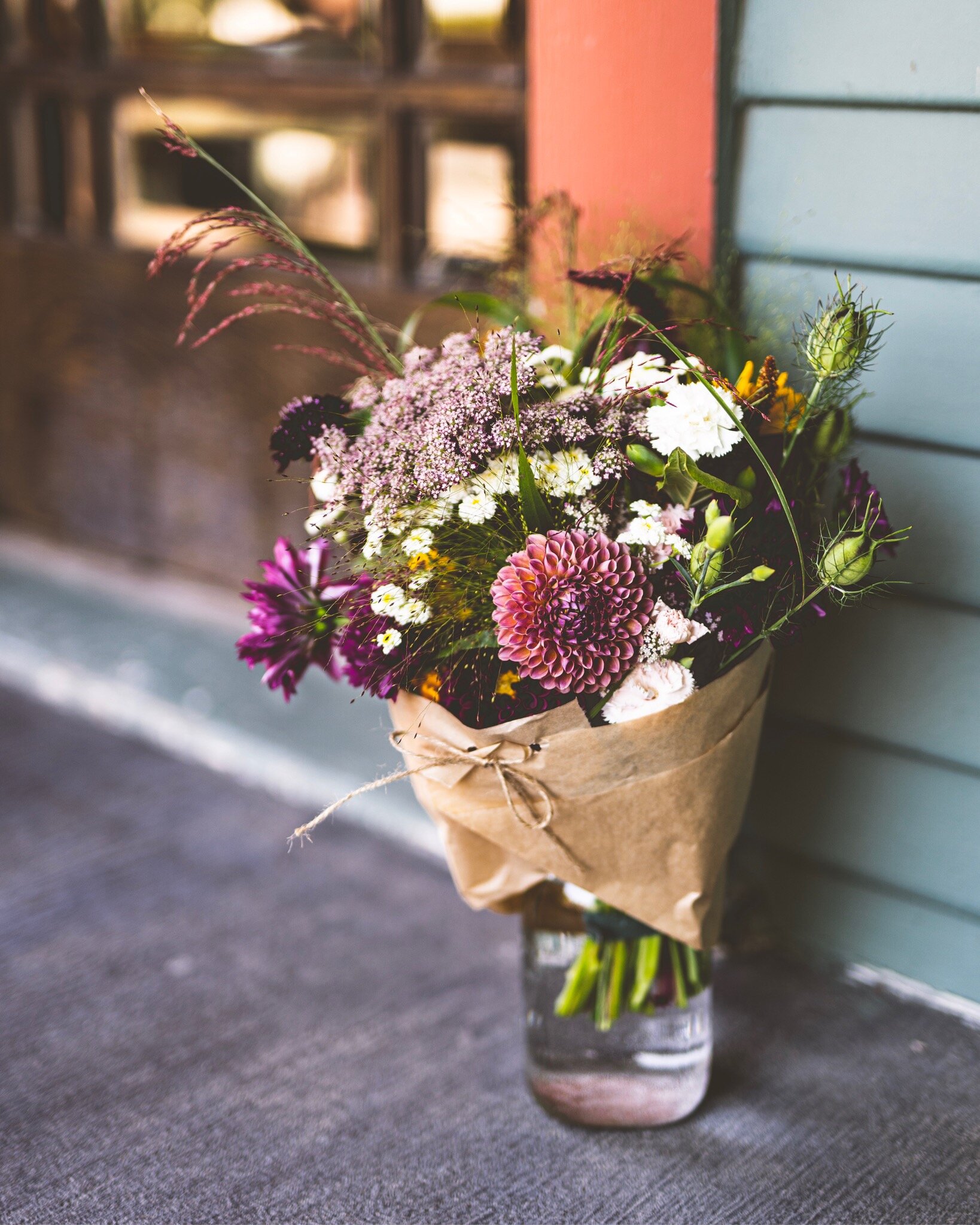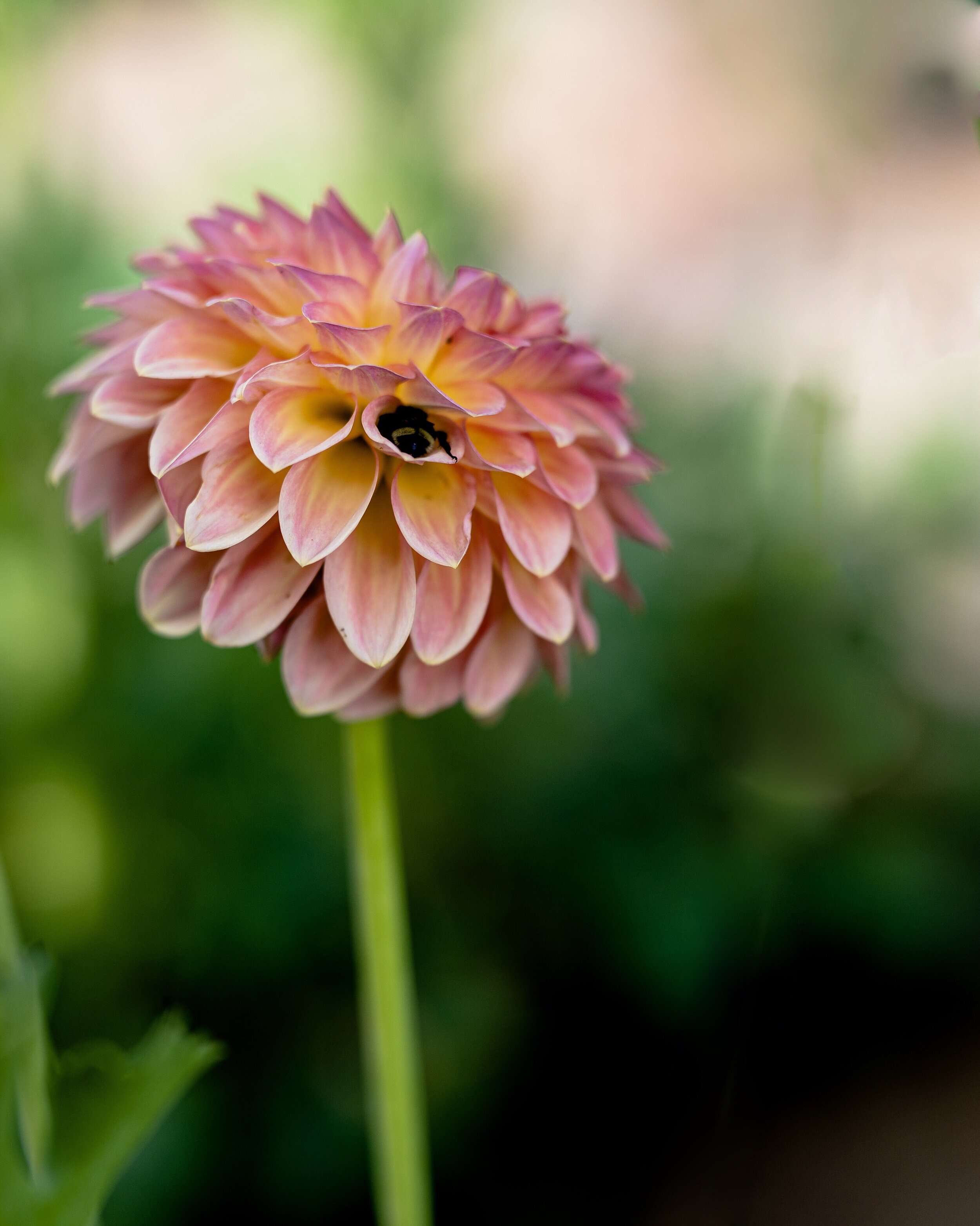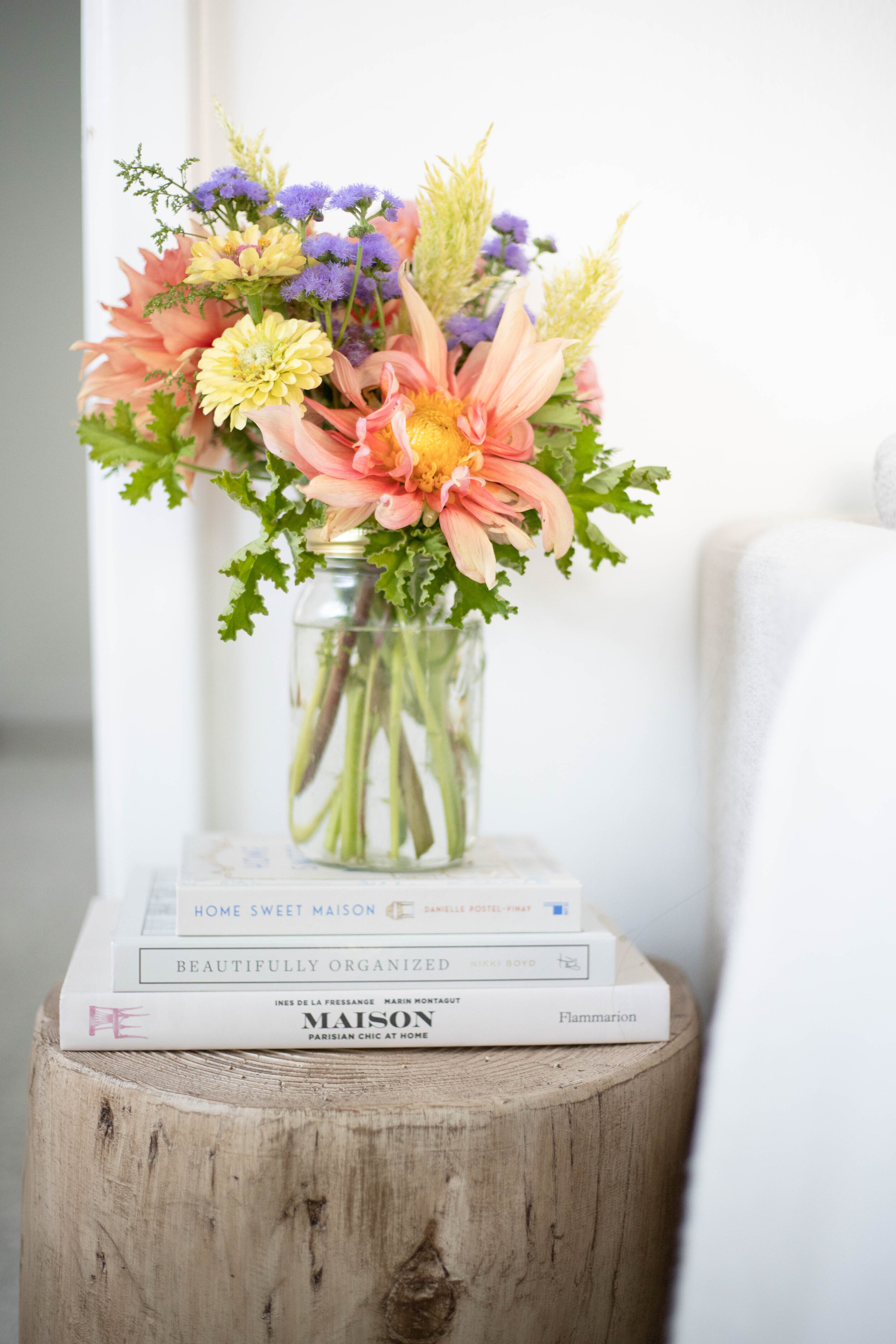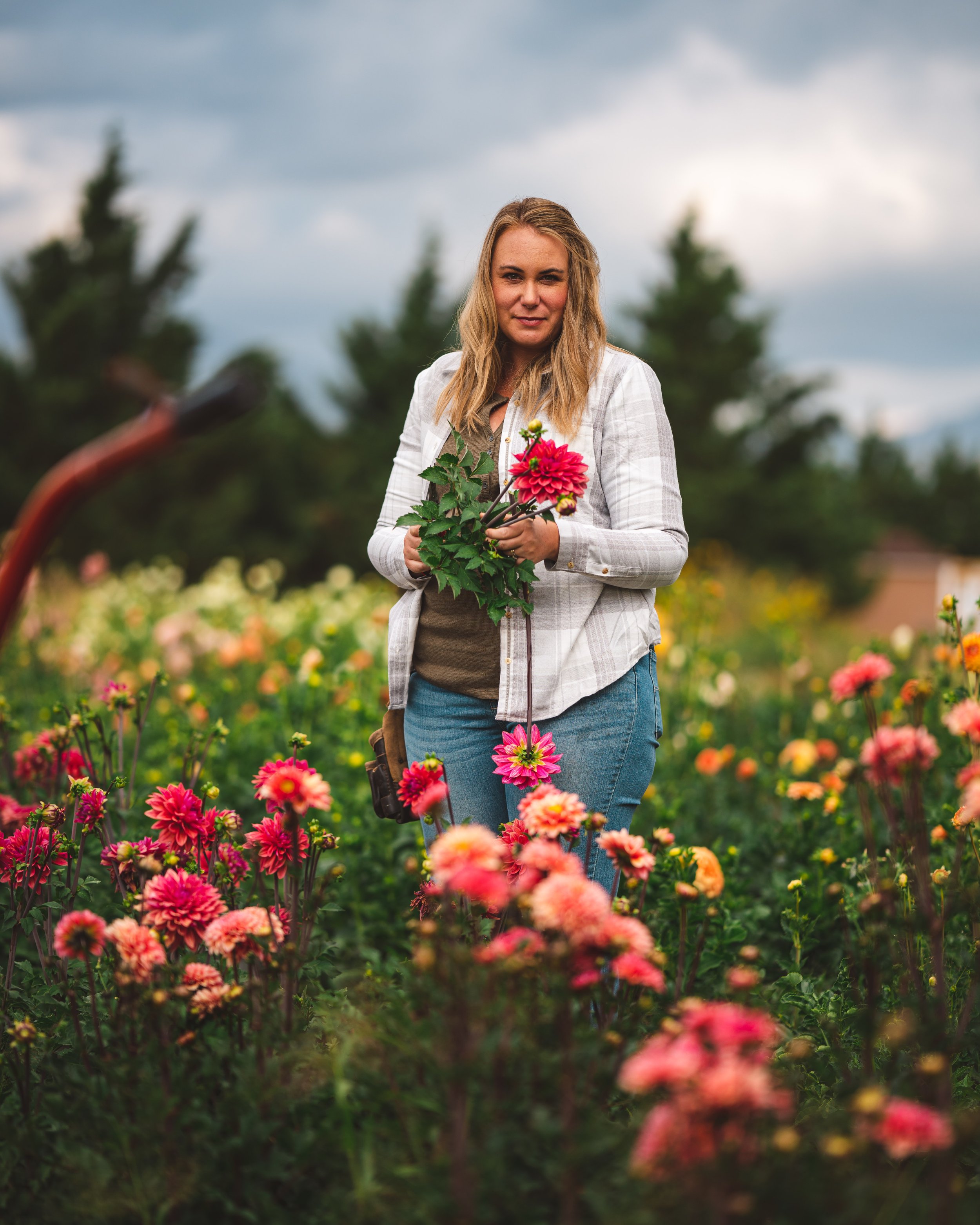Farm Update: The Story of a Neglected Field to a Thriving Flower Farm
I cannot begin to tell you how many times I have sat down to write an update about all the happenings going on our tiny flower farm. Then something else demands my attention and by the time I circle back to finish the update it has become old news! Here it is, on an outrageously windy September day with the first winter storm blowing its way in. Running through the dahlia patch tearing all the dinner plate dahlia heads off in attempt to keep their weight from breaking the rest of the plant. Between today’s wind and the forecasted temperature tonight: this may be the end of the 2019 dahlia season. My hair looks like I am a crazed woman and my eyes still weepy from the remnants of dirt blown in my eyes. I am no small gal but those gusts out there are insane where it even caused me to stumble back. Of the many tasks we did not get to, trellising the dahlias and many other plants was a biggie.
On the brink of our season’s end, we are being taught just one more lesson of the importance of each task we must make time to complete. Though I would feel better knowing that we did everything possible, such as the trellising, I do not think that would have saved us from these winds. A projection of 25 mph gusts but yet it must be at least twice that. The winds were also were supposed to settle once the rain hit. That also is not happening. These are the moments that I warn all our customers about. These are the moments as to why we won’t take on events past the second week into September and how I warn our September Bouquet Subscription members that their deliveries may be finished up the following spring. Despite all the warm forecasts, in one day- in one night- our season can come to an end.
This is the beautiful, volatile valley we live in. Fortunately, we had an incredible year if tonight does mark the finale of our season. As always, we will take the precautions we can but there is only so much that can be done when you field grow all your flowers.
Now, I know for the most part, unless you have seen us in person we kind of left you hanging since last winter. Back when we were detoxing our soil, the first step we decided to take in preparing our unloved patch of dirt into a thriving flower farm. The good news: we did it! Yay!
Not without many ups and downs and some turnarounds!
As I write this, we are on the brink of yet another passing of a season as fall approaches quickly. I am already excited to be making apple picking dates with good friends, being able to break out the collection of scarves again and oh yeah…. The thousands of bulbs, corms and seeds that will be flooding the family accounting office! Though, now that the in-laws expect my piles of bulbs crates… it’s almost not as fun (they still think I’m crazy but have become kind of numb to it).
Yes, we are already crop planning, seed planning and much has already been ordered for 2020. Considering the uphill battles of 2019 I cannot wait to see the accomplishments and amazing blooms we will be able to hand you in 2020 with a little head start compared to being behind all this past season.
Before we launch into the ambitions of 2020 let me catch you up on all the good, the bad and the bounty of the first season at Sierra Flower Farm 2.0 property.
Detoxing the Soil Update
I know, we completely left you hanging on this one! I have gotten your emails, your comments and inquiries on this subject. In case you don’t know what the heck we’re talking about you can read our Nitty Gritty: Detoxing Soil blog or watch us in action. So at last here are the results:
It worked!
Now, we cannot confidently say that the soil wouldn’t have been just fine without the spraying of activated charcoal but on this, we went with our instincts and still think it was the better choice. The soil had glysophate and pre-emergent as the only means of love or attention for decades. Twice a year. We faced some other hurdles with the soil (which we will get to in a minute) and through that process found out that the soil itself isn’t too bad. Once we looked into the history of the Ruhenstroth area it really clicked: it was ranch land (big duh- huh locals?). Horses and sheep are a big part of the history of this now housing development. Despite the couple decades of harsh treatment on the soil here the dirt itself has a different story, one that wasn’t wiped out from harsh chemicals and neglect.
The dirt tells us its potential and are honored to bring it back to what it once was: healthy.
We noticed happier plants in the areas we had treated the soil with activated charcoal. In the rush of opening a few rows, we ended up skipping the detox step. I will say, it was some of the worst marigolds we have ever grown. Coincidence? Perhaps. Though we realize there is much work needed in the soil in general, after seeing the difference between the rows that had been detoxed this is a step we would not choose to skip again. It doesn’t hurt the soil, it only helps. We will be keeping this as part of our regimen for sure as we continue to open new patches. Also, we are going to be experimenting by adding the activated charcoal as an amendment in the soil beds we are gearing up to prep once we get out first couple kill frosts.
Bottom line: if you are breaking ground that has been continuously sprayed with herbicides and pre-emergents: take the guess work out and spray down some activated charcoal. We also have a well on our property, our neighbors all love glysophate. We can’t stop the neighbors, nor do we care to carry that torch but there are studies that show these chemicals end up in our water, especially when on a well. We can at least start the process of detoxing and pulling those chemicals out of the surrounding soil on our property, near our well. Will it do a ton? Probably not but it makes me feel better!
Our Hurdles
The “Clash of the Petals” saga continues
Wow, where to even start?! Except that… we love to learn things the hard way. Also, we have learned that any market grower, farmer or seasoned gardener knows that face planting in mistakes rather than planting those pansies ensures the creation the exact recipe to make you learn fast!
One thing with the new property we did not have the advantage of being able to fall plant or fall prep. Heck, we barely got winter or spring prep. There was no preparation this year. We continued on our path of triage. We were still living out of boxes and frozen dinners while fixing up the old house to get on the market (what a nightmare). Graham had work deadlines. He had bowls. I had wreath season. I had seeds to start and not even the greenhouse was assembled yet. We were going with hopes and dreams and not much else.
Our new house was gross, infested with mice and the water in the kitchen would only trickle. As we invested money and energy into our old house, which was looking like an incredible upgrade. I was finding gutted mice from our cats under moving boxes or just in the middle of the floor. It was depressing and with every turn something else major would go wrong with the new house. On top of it, we hadn’t even gotten to start on the one reason we took the turd palace: to grow flowers. It was a frustrating season of our lives to say the least!
We literally got the fancy daffs and tulips nestled in the ground on Christmas Eve. Yup, that’s right. We winter planted those guys. In our area, it was still in the realm of enough “chill time” but we were cutting it dangerously close. Planting late doesn’t give the bulbs enough time, not only enough cool time but to begin establishing roots. Healthy established roots helps eliminate bulb rot, gives longer stems and healthier flower heads. We also are working with silty/clay soil which can become waterlogged with too much snow or rain.
If we had an incredibly wet and harsh winter we would lose this bet. We haven’t had one of those winters in years! If we did, we would face rotting bulbs and a lot of invested money and time.
What was the chance of that though, really?
We lost that bet.
This is one of the reasons we avoid casinos like the plague despite living in Nevada! I am not the gambling type.
We had one of those winters that only comes every handful of years. We had rain. We had snow. That drought everyone had been biting their nails over and Lake Tahoe being emptier than ever before? Well, this winter fixed all that! It stayed green in our area up until a couple weeks ago. Job’s Peak had snow up until a couple weeks ago, abnormal for us! Our valley had more bugs, mosquitoes and water than it’s had in a long time. With the good comes the bad and we definitely had some struggles.
Okay, at least we didn’t lose everything just a thousand or so tulips. The fancy daffs stayed fancy but after a super crazy winter of snow/rain it got crazy hot then cold and the pattern continued for a good three months! Daffodils have slime but I have never seen them ooze this bad, all I can figure was the weather fluctuations had quite the impact on them.
The poor sweet peas, stock, ammi… didn’t know whether to grow a ton or wait out the cold. It was a mess. They would shoot out growth, just for it to be killed by frost the next day. I could see that the plants were not getting the needed nutrients/water/etc to be able to handle the extreme weather fluctuations. Tunnels were put on, then taken off and moved to the next most needy plant and then put back on. It was like survival of the fittest out there for many of our spring flowers. Resources had to go towards our higher end flowers (ranunculus and anemones) while everything else were at the mercy of the elements.
Anyways, you get the drift: the weather was insane. The winter has a harsh one.
We were off to a great start.
We got a little salty…
No, no one got sassy or butt-hurt except perhaps our soil.
If the hurdles of late planting due to moving and fixing an old house in conjunction with a big winter wasn’t enough: we created our own hurdles. Yes, we are great at shooting ourselves in the foot (or I guess in my case- dropping clippers into my foot, don’t harvest flowers bare foot!).
Now, this next hurdle is going to deserve it’s own post and video! It is a doozy and it is an incredibly common mistake that many of us make without even realizing it: we made our soil salty.
What? Were we trying to keep the Sanderson sisters out of our garden with a Costco size of Morton salt?
That would make for a much better story but alas: no.
We followed the guidance repeated over and over by more seasoned growers and flower farmers: we ended up adding too much quality compost.
I know! How is that possible?!
The thing is: we didn’t even add the recommended amount of adding “good quality compost.” We added about two to three inches worth. Less than half of the normal recommended dose you see time and time again. How we puzzled our way through this and were able to reverse much of the damage is beyond me but don’t worry I will share all! The synopsis is that we couldn’t find “quality” compost without animal waste. No, no we did not burn our plants- it was all well aged but even a properly composted manure still has byproducts: nitrates also known as salts! We went through sending in plant tissue samples to our local university, quick soil sample tests we snagged on Amazon, talked to the local compost guru, talked to other grower friends, searched the internet high and low.
We had compounded nutrient deficiencies, dehydration and stress. No disease. No fungus. Hours of research and late night panic attacks brought me back to look through the ingredient list of the local compost guru, we were ready to shovel the premium dollar to this supplier in hopes their black gold would aide us in fixing this while we watched: ranunculus stems collapse, sweet peas just sit there yellowing, ripping out a entire row of shriveled snapdragons. It was gut wrenching. The compost gurus warned of only using minute amounts (like a 1/8 of an inch-1/4 max of an inch per row) of their compost started me on the research journey of “why?” Why are these local compost gurus saying something different than all these seasoned market growers? Then I noticed the “wild mustang manure” well heck poop is poop and it is considered a safe and quality compost (for the most part, we will talk about that another time).
We then began really researching the use of composted animal waste in our soil. Well aged is a must, it will keep from burning the plants with too much nitrogen, right? The thing we skipped over (which is something I suspect most of us do until it hits us in the face) is that the composting system still leaves byproducts. Urine, poop- once broken down they leave the nitrates behind. They leave salts behind. If it’s animal waste it had salts. End of story. Period.
When you pork down a bag of Lays potato chips in one go, don’t you feel thirsty and dehydrated? Or as my sister-in-law calls it… “pickled.”
That is when we became suspicious of the aged manure we used. How to fix that?
Back to the fancy guru compost. This compost ain’t cheap. Like it hurts it is so expensive. Other flower farmer’s be like “look at this wonderful dump trailer of compost I had delivered for $100.” Well, that’s not our area and you all are lucky! The type they recommended they said was tailored to the Nevada soil. It had amendments to help the plants thrive despite the harsh soil and harsh climate.
Interesting.
The ingredient that really piqued my interest in the local compost was “yucca powder.” Hmmm this sent me down another rabbit hole- why yucca? Lo and behold the yucca ended up being the very answer we needed.
If there is one thing to add to your gardening emergency kit it would be yucca saponin. We settled on the biggest problem we were facing with our soil was the salt buildup from the aged manure. Nothing else was doing much good. Too much of a good thing our main problem seemed to be. We decided to address that by flushing the soil with yucca saponin. Yucca is this amazing product that helps flush out salts from the soil and helps plants better uptake water. Many hydroponic growers use yucca saponin to flush out their growing medium. Because… fertilizers create a salt buildup! Every few weeks they are flushing the growing medium through their fertigation system. We are on to something. We grow in the ground and haven’t put much thought of taking an active approach in flushing the soil. These hydroponic grower’s flushing choice? Yucca saponin. There were many other great ingredients in the local compost and by researching each one we really learned a ton.
We used some of their compost in their recommended amounts in the new soil beds and spread out the concentrated soil that we messed up on. The main beds we reserved this uber expensive compost for: the dahlias.
We flushed the beds that wannabe survivors were still hanging in there for us. We also let nature take its course. In the worst of the beds, we grew squash and zucchini (anyone want some?!) after ripping out hundreds of phlox and snaps. Overall the best thing to heal soil is: flushing it, growing in it and giving it time. It was a good battle for about two months but it paid off. Filling our watering can and generously flushing the soil every couple weeks. By hand. It was a labor of love and desperation but it saved us.
Don’t get me wrong. We had lost thousands of transplants. Between them dying from the soil mistakes or being too past their prime to even bother planting. We learned some tough lessons. We think these hurdles have taken us to another level as flower farmers and market growers. It definitely made us become more serious as growers. Thankfully, as our growing mentor told us “there isn’t much you can do to the soil that you can’t reverse.” They were right. We were able reverse most of the damage and still have a great spring crop that lead to an even better summer one! In our haste to fix that clay soil and following generic advice it almost cost us our spring season. Halting all planting for almost two months, until we could figure out what the heck was going on, was a heartbreaking but necessary decision. A decision that at the time sucked but now on the other side, was the best decision we could have made. Taking that time ensured a successful summer crop.
Plants like water
And we didn’t have enough readily available for them.
Irrigation was another hurdle. Not only did we need to run and install irrigation out into the field but we had to fix the existing irrigation to do that! What can I say, we bought a neglected unloved home and it has quirks. Like the duck pond feature in the middle of our lawn we did not anticipate having…
During the spring months our plates were overloaded. Graham was wrapping up tax season at his grown up job. I had orders to fill, weddings to design for and failing or delayed flowers. Luckily, there are some amazing local and nearby flower farmers that I was able to reach out to in my dire need of flowers. Besides, a quick drive to the Sacramento Valley was a refreshing and much needed break from all our growing troubles at home.
We were breaking ground, starting seeds, halting growing and on top of all that?
Hand watering. Ugh.
At the peek in early June, we were hand watering a good twenty 50-foot rows by hand with our frakenhose. It was always a battle of who was up to it? The short answer is neither of us wanted to! It really was a two person task that we even trained up our girls to help with. Someone watering and someone guiding the hose to not break delicate plants. If I never have to hand water again it would be too soon. Hand watering is inefficient on so many levels but with our clay/silty soil that it a lot like dealing with peat moss: when it’s dry it is near impossible to hydrate but once wet it is a difficult balance and not to oversaturate.
During the months of May and June, in the mornings before Graham went to work, on his lunch break and our entire weekends were spent digging trenches and Home Depot runs all in the name of getting that pesky irrigation installed. Even our girls helped by running drip tape down the rows while I planted all the transplants like a mad woman. It was getting down to the wire for those guys: in the ground or in the compost pile and many did end up in the compost pile. Within a couple weeks time, I planted over 600 dahlia tuber clumps along with thousands and thousands of plant transplants: tomatoes, lisianthus, gomphrena, cosmos, zinnias and more. The only break I took from the field was to fill orders, design for weddings or taking my kids to and from school. As I did that, Graham hustled to get everything in place so the transplants can be efficiently watered and thriving.
We’ve experienced end of season burnout. Most market growers do. It’s the end of a long season but also the beginning of a new season. This typically happens in October. We were burnt out in June. That was rough. We had to delay going to farmer’s market and just barely began making any kind of presence at Eddy Street. This was not us. At the end of the day, we worked harder than we ever have. Often, from sun up until about eleven o’clock at night with headlamps. This is the not so glorious part of growing flowers.
We were sunburnt, tired, questioning what the heck and why the heck were we doing this? Was moving to this turd palace worth it? Everything was put into this, we were stuck now. What did we get ourselves into? Money, time, sweat, tears, blood draining out of us with little return. With Sierra Flower Farm being my dream, I was feeling like I failed our family on a pipe dream that I couldn’t make work. My kids crying saying they just want a snuggle time or just a day of fun away from the flower field. My husband stressed beyond stressed facing heat stroke, sore muscles, lack of sleep. Crop failure after crop failure. We hit our bottom. Each for our own reasons that wound back to the flowers.
We felt defeated.
Obviously, not defeated enough to throw our hands up in the air and not keep trucking along.
We did not do all this for nothing.
We were going to do everything in our power and then leave it the One truly in power and just see.
That’s all we could do.
Getting the irrigation installed seemed to be our bottom for the year with everything. Once we got that in, along with all the other measures we had taken, everything went up from there (literally).
2019 Hurdles conquered and the closing of the clash if the petals saga
In growing, on any scale: there are going to be hurdles.
There are going to be many hurdles that are out of our control. There are going to be a ton more hurdles that we cause ourselves. Persistence, research, asking those with more wisdom and analyzing will reward you. Perhaps not to the degree you wish but it will, especially in the long run. Fortunately for us, we reacted swiftly. We saw the decline. We did everything to save the spring crops but knew that the future of our season depended on the summer crops. Especially the dahlias. That was our big investment for this year, it was our “go big or go home” crop. It could make or break our season depending on the success of this flower. Yes, we put all our eggs in the dahlia basket. As I cried over ripping plant after plant out of the garden beds, we knew we had to do right by the dahlias. They could make up for our shortcomings.
We pulled it off. They pulled it off. The dahlias made our season.
Not saying that much of our other flowers weren’t rockstars: because they were. Sure, there were a handful of varieties that were not our best we have grown (I’m looking at your marigolds!) but others had me falling in love with them all over again (swoon chocolate lace flower, swoon).
The majority? Were absolutely the best quality we have ever grown. The new property has become a successful flower farm. We have taken an old neglected piece of land and have turned it into a thriving flower farm. People who saw us as hobbyists began taking us more seriously, we were able to fill orders without batting an eye: we had plenty of product to go around for the first time ever. Last minute orders, market, bulk buckets, events, weddings: we did it all.
Healthy flower heads and great stem length. Of course we look at our field and see the shortcomings, we see what we can do better or should have done better this year. We mainly see our successes. The rocky start to the season made it that much more sweet. You definitely appreciate the things you have to work hard for.
A family friend, who is a seasoned farmer gave the best compliment I could have gotten from anyone “You guys did great with the flowers. I know how much hard work it is and how much hard work you guys put into it. Good job.” Our 2019 season boiled down to that line.
There is no dancing around this one: we did work hard. For myself, I don’t think I have ever worked harder in my life as I have this year. With taking on more space, Graham can only do so much of the “boy work” and I had to carry my own weight. I must say, I have gotten pretty strong this year! It definitely has made be feel a more empowered farm-HER but also thankful for all back breaking work Graham does for the flowers. For me.
Season Recap
2019 was the worst and the best year we have had so far. Our lows were pretty low but the highs went beyond our dreams for this season. We poured ourselves into the flowers this year in more ways than I can say in words. I say “we” but it was much more than Graham and I. Our girls made sacrifices, our girls helped in the field. We, as a family, poured everything into this season. I must admit after this past season I am shocked that both our girls want to grow up to be flower farmers…well… and bakers… and singers. Those girls at such young ages aren’t afraid of hard work and long days, that definitely wasn’t me as a kid!
The struggling sweet peas I wept over eventually outgrew our salty mistakes and thrived. They swallowed their trellis, gave the first delicious scent in the new garden patch and became a magical place for two little girls to partake in tea parties and hunt for fairies.
The ranunculus with collapsed stems, we were able to save those as well. Some shade cloth and routine flushing with yucca and we have giant heads of ranunculus: better than ever. It made for some happy brides.
The anemones were amazing this year, the stems were the length of my forearm and biggest flower heads we had ever grown.
If this is the result after all their struggles to survive: we cannot wait to see the results with better soil and on time planting.
Weddings
We had the best brides this year. The kind of brides that remind you why you love to grow and arrange flowers. The ones who sought us out, not to replicate a Pinterest photo but to create a custom made bouquet for them. Working with these brides was a dream come true. Each bride was gracious and laid back. They were beautiful inside and out. I was incredibly honored and humbled to be able to be their wedding florist and farmer. After this season, I am excited to take on even more weddings for 2020! Thank you to all my amazing 2019 brides for boosting my confidence!
Bouquet Subscriptions
Our bouquet subscription was bigger than ever before! We have incredible members and they stuck with us all season, despite the rocky start they supported us and had faith in us. Our members are truly the heart of Sierra Flower Farm. With opening up deliveries to Reno, it kept me very busy! Nothing like a nice drive with my girls, to deliver fresh blooms while blasting 80s pop music. At the end of the delivery day, we all celebrated with a delicious goodie: be it a cupcake or ice cream! Tuesdays and Thursdays have become special for us and for many of our members. I have never seen so many happy people on a Tuesday! “YAY IT’S TUUUUESDAY!”
But that’s what flowers do. They transform an ordinary day into an extraordinary day. The make a rough day a little brighter. We just so happen to be able to bring that beauty right to their door. Many times it seemed like it was on days they needed it most or perhaps we all need flowers in our homes more often than we realize.
“It made me realize…
… how much I adore our community, our supporters and the outlets we are incredibly lucky to be vendors at.”
Back in Action!
When we finally made it back to Farmer’s Market we were welcomed with so many hugs, smiles and had our best markets ever! Encouraging words and expressions of how much our flowers were missed. How much our family was missed. It is touching, everyone loves to be loved and missed!! We had the same warm welcome back at Eddy Street when we finally came. By the time we were back at our normal outlets I felt like I had crawled out from a cave.
It made me realize how much I adore our community, our supporters and the outlets we are incredibly lucky to be vendors at.
We ended the 2019 season by doing something incredibly out of our comfort zone: we opened our home and field to guests. The day we had our Open House Event was literally the one year anniversary of getting the keys to the new property. To be able to celebrate with our amazing community of customers, friends and family was the most incredible experience. Everyone sees pieces of our story, they see a part of the farm but they have never gotten to experience it firsthand. To finally be able to welcome guests was a great feeling. The day was pure magic and I am looking forward to sharing that in an upcoming blog. In the meantime check out Holcomb House’s amazing little blog about their experience at our Open House Event here.
What’s next for Sierra Flower Farm 2.0?
To make it even better! To grow better flowers, to grow more flowers, to make the soil healthier, to expand to the next patch of the field, to hand- to get local blooms in more people’s hands and homes! To bring more beautiful photos and create more content. To do everything we have been doing bigger and better!
Though there are still technically a few months of the 2019 season left we are gearing up preparations for 2020. This is our first year we will be able to really fall plant and fall prep and we are absolutely ecstatic about this! A kill frost can be here anyday (heck, tonight!) which will give the final curtain call for most of our cut flowers for the year. That is when the transition to wreath season, family time, and focusing on next season commences.
We have some incredible new-to-us varieties of ranunculus coming in the next couple weeks and I am eager to pre-soak those guys! Last spring, we were able to show you that part of the process but due to us trying to stay above water, we never got to show you the process for pre-sprouting and planting: that will be coming soon! Along with that, we will be showing you the process of us fall planting tulips, narcissi, along with many other spring favorites! First, we’ll have to pull up and store our dahlia tubers: we can’t wait to show you guys the method that has worked for us! Being in such an arid and cold climate, storing dahlia tuber is a bit of a struggle for us. Plus, for the moment, we have limited storage space. We’ll be taking you through that process.
Overall, we can’t wait to get back to blogging and vlogging! It was something we had started, then had to shelf but are really looking forward to dusting off our equipment and getting back to it!
On that note: if there is a certain topic you want us to tackle: spam our email or comment below! We would love to hear from you and if we can, we will tackle your requested topic!
In 2020 we are looking forward to bringing new offerings to our bouquet subscriptions. We are taking our bouquet subscription program apart and rebuilding it up! Don’t worry, we will leave the best parts! We wiill be opening sign ups for our 2020 SPRINGing for Flowers subscription in the next couple weeks along with pre-orders for our traditionally made holiday wreaths!
I know, we haven’t even put out pumpkins and I’m talking wreaths but the holiday season approaches fast! I am looking to start delivering holiday wreaths the week of Thanksgiving, just in time for your front door to look in the holiday spirit just in time for the most magical time of the year!
After the Open House Event it rekindled a desire to host classes. 2020 will be our year! We are looking forward to offering design class on the farm in spring and in late summer. This will be fun! Great for DIY brides, a girls date or simply for the fun of getting to play with some interesting locally grown flowers. We will keep you guys updated on the dates and what exactly these classes will entail! We will also be opening up the field to our photography friends a few times throughout the season. That way you get to see the field in all the different seasons! Here at Sierra Flower Farm we believe down to our core the importance of enjoying and celebrating each flower in their rightful season and would love to spread that message through all our amazing photography friends.
We are also looking forward to offering wholesale services in 2020 for our local event florist friends, this is something we have wanted to do, thought this was the year but are feeling great about pulling it off for next season! We have heard your requests and are working diligently to be able to produce enough quality flowers in the varieties desired for you. Any florist friends interested, please email us so we can get your on our wholesalers list.
A long post but overall, that is our farm update that encompasses the bulk of our 2019 season on the new property. It has been quite the year. It has reignited our passion for growing, harvesting, designing, writing, filming, photographing, dreaming: just everything! It all comes down to we love what we do, we love handing each of you blooms and sharing knowledge. We have some goals. After this year, I think we can do just about anything and we are excited to have you on this journey with us.
Thank you for all your support. Each of you near and far kept us going during the roughest times and allowed us to continue dreaming big.
We are looking forward to handing you blooms soon!
Thank you!










